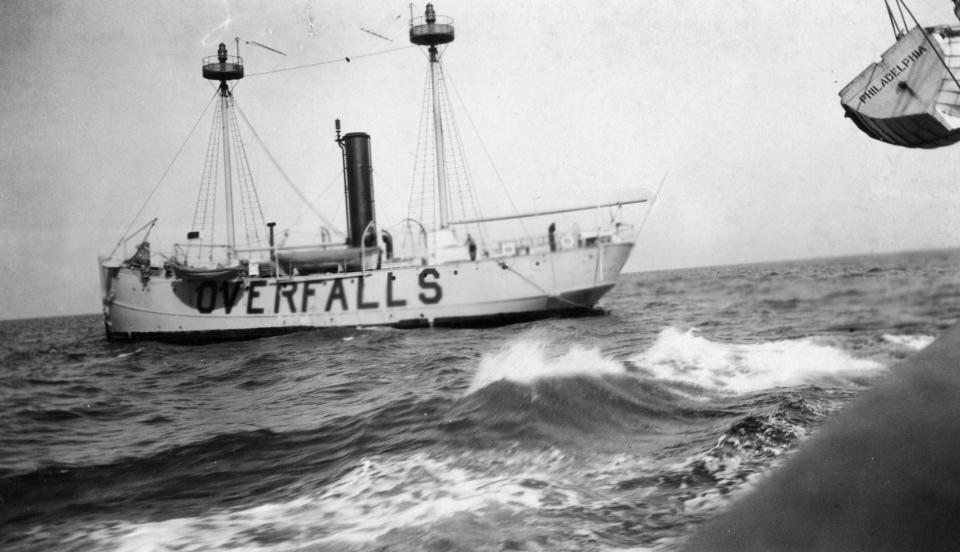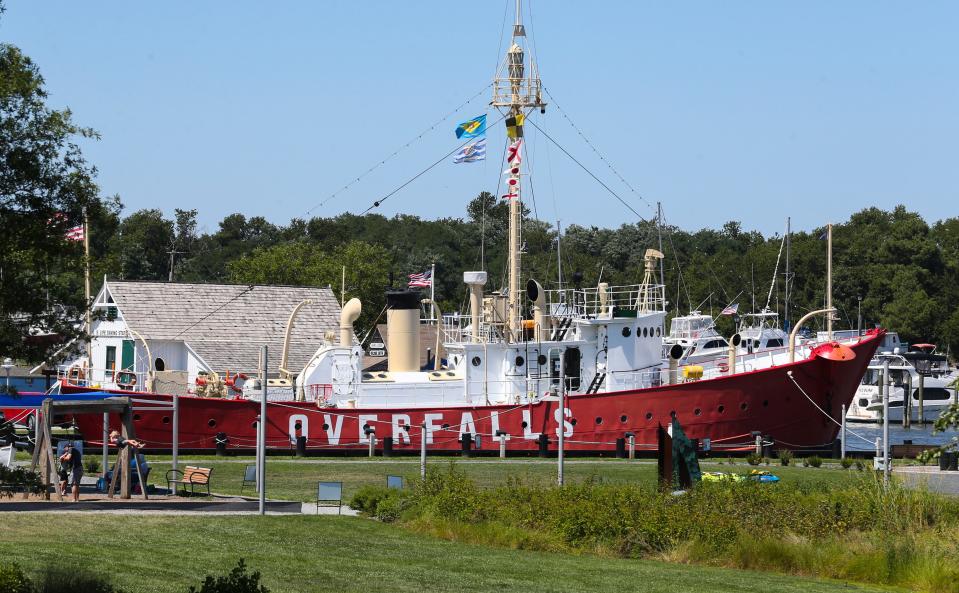The tale of lightship Overfalls and an umbrella-eating shark
Mako, hammerhead and other sharks regularly swim in the waters off Cape Henlopen, but most of these large creatures remain a good distance from the beach. Few Delaware beachgoers encounter sharks, but fishermen and others who work deeper waters sometimes come face-to-face with fearsome sharks
In the early 20th century, the lightship Overfalls sat in the middle of the shark habitat as it maintained its station off Cape Henlopen to warn mariners off the shoals near the mouth of the Delaware Bay. The crew of the lightship rarely gave sharks a second thought.
In August 1911, one of the crewmen was fishing from the lightship when he snagged something big, really big. On Aug. 26, 1911, the Middletown Transcript reported, “A shark of the man-eating species, 17 feet in length, caught today at the mouth of the Delaware Bay after a hard fight by James Keyes, a member of the Lightship No. 69… Keyes brought the big fish to the surface only after a hard battle. He was forced to use a steam winch to land it on the deck of the lightship.”

At the time, the production of umbrellas and parasols in the United States was big business. According to the Smyrna Times, “No one firm makes an entire umbrella. The ribs and braces are made in one factory, the sticks in another, and the little catches that slide along the stick in still another, while the silk is imported.”
Using this highly organized supply chain, American manufactures were able to produce 2.5 million umbrellas and parasols every year, more than any country in the world.
A century ago, an umbrella was an important fashion accessory whose style reflected the character of its owner. Although a run-of-the-mill umbrella with a simple cloth covering could be had for as little as a dollar, Wannamaker’s department store in Philadelphia offered top-of-the line umbrellas that sold for as much as $45.
The department store claimed, “It is not showy. The handle is simple — a post of light-colored wood, highly polished with a cap of gold and a neat leather strap. But the covering is of the finest quality of silk made for umbrellas any where in the world, and the frame is of a famous English make that we have never heard of as breaking.”

Every year, umbrella makers produced new handle designs to give the fashion conscious buyer a distinctive look. Handles, which came in a variety of shapes and colors, were made of wood or ivory and often bore the owner’s monogram.
In 1911, Laura Dorsey, of Sangatuck, Connecticut, bought a fashionable umbrella with a distinctive monogram on the handle. The umbrella promised to giver Dorsey long years of use, but unfortunately, while on a steamer in New York’s East River, she dropped the umbrella overboard.
Several months later, in August 1911, James Keyes wrestled a large shark aboard the Overfalls lightship. The size of the shark was stunning, and when it was cut open, the animal’s stomach contained a quantity of junk, several large pieces of oil cloth, and the handle, ribs and covering of an umbrella.
The story of an umbrella-eating shark was carried in newspapers across the country and read by Laura Dorsey, who had dropped her monogramed umbrella overboard near New York City.

Dorsey wrote to the captain of the Overfalls and described the umbrella and its peculiar monogram on the handle. Based on her description, it was confirmed that the umbrella was hers, and it was sent to Dorsey.
The incident proved not only the great range of sharks and their indiscriminate appetites, but it also demonstrated the value of a high quality umbrella.
WHITE MARLIN OPEN: White Marlin Open to mark 50th anniversary with huge purse, new category: What we know
BEST BEACHES: The best 'secret' beaches in Delaware: Broadkill, Pickering, Slaughter. Plan your visit.
Principal sources
Evening Journal, Aug. 18, 1911.
Middletown Transcript, Aug. 26, 1911.
Smyrna Times, July 18, 1888.
Every Evening, Wilmington Daily Commercial, July 16, 1921. 7-16-1921
Keowee Courtier, Walhalla, South Carolina, Sept. 13, 1911.
Donaldsonville Chief, Donalsonville, La. Nov. 18, 1911.
Greene County Herald, (Leakesville, Mississippi), Nov. 10, 1911.
Monmouth Inquirer, (Freehold, New Jersey), Oct. 26, 1911.
This article originally appeared on Salisbury Daily Times: The tale of lightship Overfalls and an umbrella-eating shark

